Research Reports / Rapports de recherche
Researching Alberta's Gas Technology:
A Case Study — The Turner Valley Gas Plant1
1 Crude oil and wheat have long represented for eastern Canadians what Alberta is all about. Rotary drilling rigs, flare pits, pump jacks, and refineries have been blended together with golden wheat fields, combines, and grain elevators in the minds of easterners until they have come to be seen as the keys to Alberta's economic good fortune. In this there is the usual element of truth. But natural gas, like the less glamorous cereal grains, oats and barley, remains largely in the background; it does not come to the fore with the same frequency, nor does it evoke the same vivid imagery. Similarly, the evolution of gas technology does not attract quite the same attention or interest as the technology behind the extraction of oil from tar sands or new methods of drilling at odd angles or great depths.
2 And yet the gas processing industry has undergone a number of interesting and important changes over the years and nowhere is this more evident than at a recently declared historic site, the now closed Turner Valley Royalite #1 Gas Plant. In 1985 the plant ceased operations after some seventy-one years, and its shutdown brought to an end an era in the history of Canadian natural gas processing. Canada's oldest gas processing plant operated over all those years with a number of changes in techniques and equipment, and today it is the only plant of its kind in existence in Canada. As this article will attempt to demonstrate, the resources available to the researcher who wishes to highlight the importance of the Turner Valley plant in the history of the Alberta gas industry, and to place its technology in the mainstream of gas processing technology world wide, are in a good state of preservation, they are accessible, and they are both varied and informative.
The Nature of Natural Gas
3 What is natural gas? In short, it is a mixture of gases, principally the hydrocarbons methane and ethane, which occur beneath the surface of the earth. Its combustion accounts for over 20 percent of the energy generated from fuels throughout the world, and it is also a raw material for the making of various chemical products. Natural gas is the most volatile form of crude petroleum and it is often found together with the liquid forms because the same geological conditions are also favourable for producing deposits of the liquids and the gases. Most of the component parts of the gases come from the organic matter in sediments transformed through geological processes that took place over extremely long periods of time. Other components of natural gas, however, were produced from inorganic matter by phenomena such as volcanism and radioactive disintegration. The gas that resulted from the different processes was trapped in "reservoirs" beneath the earth's crust.2
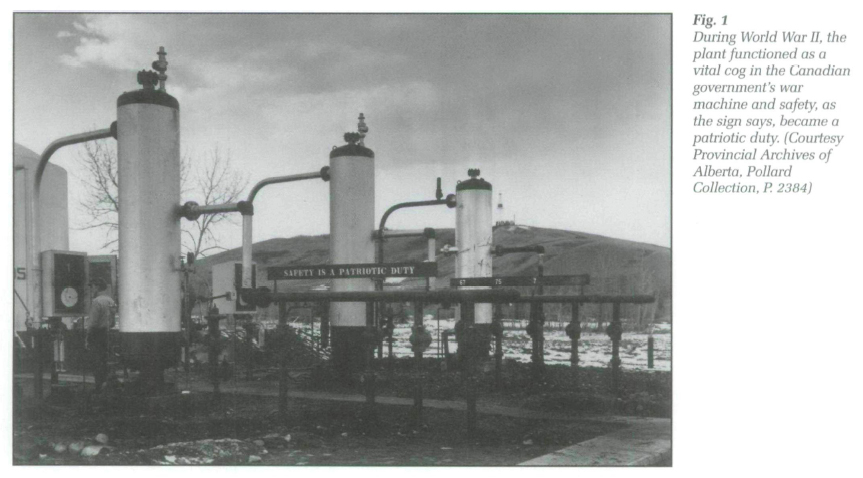 Display large image of Figure 1
Display large image of Figure 14 Producers obtain natural gas by extracting it through wells drilled into the earth. Some natural gases can be used just as they are produced at the wellhead, without any processing or refinement. Most gases, however, require processing, which generally consists of condensing the less volatile hydrocarbons, which in turn yields large quantities of liquefied petroleum gases, mainly propane and butane, and removing the less desirable constituents such as carbon dioxide, hydrogen sulphide, and other sulphur compounds.3
5 Natural gas is transported either in its naturally gaseous state by pipeline or, after being transformed into a liquid following cooling to –160°C, by tank trucks or rail cars. The liquid form occupies approximately 1/600th of the volume of the gas.
The Early History of Natural and Manufactured Gas
6 The use of natural gas by human beings can be traced back to China where, around about 900 B.C., we have the first written evidence of this taking place.4 Natural gas from free flowing wells was seeping to the surface and as early as the third century A.D. it was being employed to illuminate temples. Tenth century Bejing had streets lit with natural gas, and the Chinese were the first to build a gas pipeline and to use the gas for industrial purposes. The pipeline, made from lengths of bamboo, carried the gas from the source to the lamps at the place of consumption, while on the industrial level the heating power from gas was employed to extract salt from brine.5
7 The rest of the world lagged behind China. By accident, the Flemish chemist Jean van Helmont (1609) found that coal, heated in a sealed crucible, produced a wispy substance, which he termed gheest, or ghost, and which we now refer to as "gas."6 This was not natural gas but coal gas, and it was his creation that was later to help fuel some elements of the Industrial Revolution and to supply light to some European cities. Coal gas was something of a secret until a German, Frederic Winzer (later Frederick Windson) arrived in London around 1807, took out a patent on the manufacture of coal gas, laid down lead pipe, and proceeded to light one of the city's most fashionable streets, Pall Mall.7
8 During the 1830s and 1840s gas was piped into an increasing number of well-to-do homes in European cities. The lights were crude, open flames shielded by glass lampshades, but they performed the task of providing light. Later, crude fireplaces were created to supply heat to the poorly insulated, drafty homes. Light from coal gas appeared first in Canada in Montreal in 1836 when the first gas works went into production, and in 1841 coal gas appeared on the scene in Toronto.8
Natural Gas in the Modern Era
9 But natural gas has advantages over manufactured gas. There is no conversion cost and natural gas gives better heat for the purchase price. In the early decades of the nineteenth century, however, the technology was not available for exploiting the gas reservoirs beneath the earth's crust. A 27-foot9 well appeared in New York state in 1821 and from here the North American natural gas industry had its beginnings. Hollowed out logs carried the gas to Fredonia, New York, where it was put to work lighting the local streets, and it seemed for a time that this city would monopolize natural gas lighting.10
10 The profit motive and American ingenuity drove the technology forward. Natural gas began to emerge as an energy source on a wider scale in the nineteenth century with the appearance of the first cable tool drilling rigs in the 1850s, and the first leak-proof pipe lines. Knowledge of geology improved and over the decades people skilled at locating the reservoirs, tapping them, and bringing the gas to the surface emerged as a new technical elite. On a parallel track, equally curious minds were being applied to the tasks of improving the first gas lights and stoves, making them safe enough to lure consumers away from a dependence upon coal.11 As the 1890s drew to a close the industry and the benefit of Robert Wilhelm von Bunsen's blue flame gas burner, and Carl A. Von Welsbach's incandescent mantel for lighting homes safely and efficiently.
11 However, a profit was, and still is, a profit, and without Samuel Clegg's gas meter the business of selling gas would not have been much of a business at all. The gas stove was also Clegg's brain child, and the fact that it extinguished its gas supply automatically when the flame was quenched made it attractive to homemakers and insurance companies alike. As the cable tool technology was perfected and the crude chisel bits hammered their way deeper and deeper into the earth (thanks to steam power), more natural gas became available. As early as 1872 the first cast-iron pipeline, a staggering 5.5 miles (8.9 kilometres) in length, was laid between the field at Titusville, Pennsylvania, and the nearby town of Newton.12
12 A device for drilling down through the earth's crust, a means of transporting the gas, and a steady supply of consumers were all available by the turn of the twentieth century. However, the processing of the product had not yet commenced. Problems associated with the transporting of natural gas over low spots in the landscape led American producers in Sisterville, West Virginia (1903), to experiment with condensing gas to remove the liquid components. Later, William Maybury (1905) introduced a Bessemer engine to compress "wet" (containing quantities of liquid hydro-carbons) natural gas, thus forcing it to give up its liquids. Gas processing had been born, and when the automobile came on the scene, the need to extract greater and greater quantities of the liquid fuel from natural gas, either by "chilling" or "squeezing," became a driving force behind the birth of the industry.13
13 The extracted fluid, known variously as "casinghead gas" or "naphtha," had formerly been burned. This changed with the advent of the gasoline engine and naphtha was blended with heavier hydrocarbons and transformed into valuable automobile fuel, the profit from which soon exceeded that from the sale of natural gas. To enhance the recovery of this now valuable liquid commodity, naphtha, compression became the norm. Later, in 1913, the concept of "absorption" was introduced whereby an absorption unit "absorbed" (stripped) all the saturates (butanes, propanes, pentanes) from the "sour" gas, that which contained high levels of hydrogen sulphide and sulphur mercaptans. The patent holder was Hope Natural Gas, a Standard Oil Company (New Jersey) subsidiary and the first absorption plant appeared in Hastings, West Virginia, in 1913.14
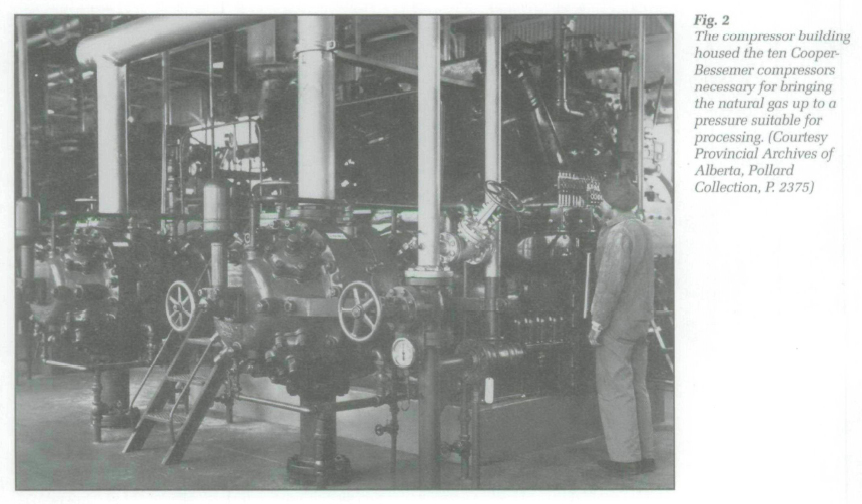 Display large image of Figure 2
Display large image of Figure 2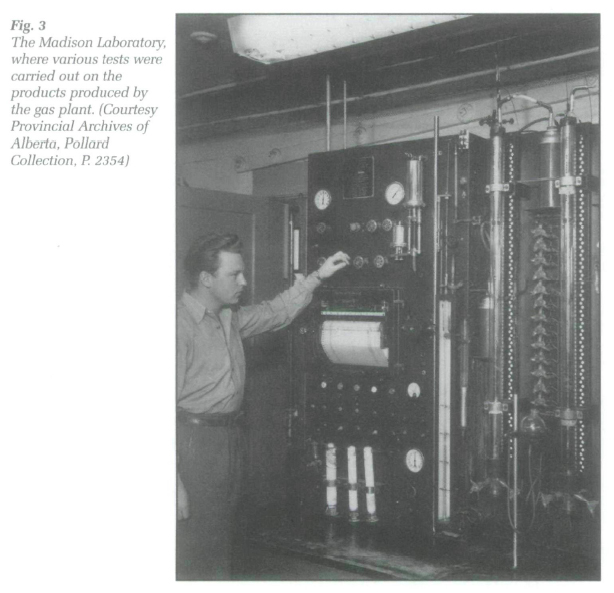 Display large image of Figure 3
Display large image of Figure 3Canada's Natural Gas Industry
14 Natural gas was first discovered in Canada as early as 1859 when Dr H. C. Tweedle found it along with oil near Moncton, New Brunswick. No commercial advantage was realized from this find. Sulphur gas was located by accident near Port Colborne, Ontario in 1866. A similar accidental find can be credited to the Canadian Pacific Railway (1883) when one of its water well crews came across gas rather than water at the 1,120-foot level (it was a very dry summer), and burning gas at 1,155 feet! This discovery at the Langevin siding site, near Medicine Hat, was extinguished and a cable tool rig was called upon to drill for gas. It found gas, of course, and at the same level as the water well rig, so that the C.P.R. station house was soon provided with gas for cooking and heating.
15 Back in Ontario, Eugene Marius Coste, a French national with an interesting past and a gift for finding gas locally (1889, 1891), had begun shipping the produce of his wells at a field in Essex County over to Buffalo and Detroit. By 1904 the Essex field had run dry, but around Medicine Hat natural gas as a source of light and heat had become a way of life.15
16 After the initial finds of 1883 other gas wells were drilled. They were producing, the pressure was about 500 pounds per square inch, and the water content was not a problem. Street-lights in Medicine Hat burned 24 hours a day in the belief that the fuel consumed was less than a lamplighter's salary. Calgary, another energy consuming centre, now began to search in earnest for a ready supply of natural gas to light and heat its residences and businesses. Its needs attracted entrepreneurs from various places, and in their ranks was Coste and a man named Archibald Dingman.
17 Coste's cable tool rigs had found gas in smaller quantities at a number of locations in southern Alberta before the big one, "Old Glory," came in at Bow Island in 1909. His 16-inch, 170-mile Bow Island-Calgary pipeline was all but the eighth wonder of the world and it helped to make his personal fortune.
18 Dingman, after several false starts, cast his gaze farther afield and became interested in the possibilities of Turner Valley through William Stewart Herron, a former oilman and hardrock miner from Ontario who had recently taken up ranching near Okotoks. By chance Herron had come across wet gas seeping from the banks of the Sheep River and realized that it was neither coal gas nor march gas, but the variety which came from a reservoir. He purchased surface and mineral rights in what is now Turner Valley and, after escorting Dingman to the site of the seepage, he persuaded him to become part of a new company, Calgary Petroleum Products (C.P.P.), which set out to drill on the Sheep River leases.16
19 Calgary Petroleum Products Well #1 blew in on 14 May 1914, producing 4 million cubic feet of gas a day soaked with a pale coloured light-gravity oil. The boom was on. In Calgary, companies claiming to be skilled in the art of finding and exploiting oil and gas sprouted overnight. Some legitimate wells were sunk and oil and gas were discovered. In the course of World War I the naphtha (natural gasoline) was taken out of the flow by separators located at the wellhead, and primitive absorption plants. A portion of the natural gas was used to fire various local boilers, or the boilers on the cable tool rigs. The remainder was flared off, a practice that persisted until the steep drop in pressure in the Bow Island field brought Coste's Canadian Western Natural Gas Company to Turner Valley in search of gas to augment the supply to Calgary. A pipeline was constructed from Turner Valley to connect with the Canadian Western main line at Okotoks and on 31 December 1921 gas from Turner Valley had arrived in Calgary.17
The Processing of Natural Gas in Canada
20 Gas from wells that are classified as "sweet" is odourless and of the methane variety. Gas that is "sour" has a high level of the "rotten-egg" odour that comes from the presence of substantial levels of hydrogen sulphide and sulphur mercaptans (a class of organic compounds with sulphur attached directly to carbon), which make it highly unstable and unsafe when it comes from the wellhead. Hydrogen sulphide is also a highly poisonous gas, fatal to humans, and under certain conditions it can cause spontaneous fires and explosions.
21 In order to make this gas usable and safe it had to be "scrubbed," a chemical process that removed a major portion of the hydrogen sulphide and mercaptan content. These early attempts to rid sour natural gas of its hideous odour and unstable properties turned into an industry that later diversified its functions and provided consumers with a collection of by-products used in homes, businesses, and industries.
22 Almost immediately upon discovering large quantities of gas, C.P.P. installed a compressor (1914) and built an absorption plant to enhance the recovery of naphtha (1914). The compressor was the first used in Canada for the purpose of recovering natural gasoline, but hundreds were already in use in the United States. What is noteworthy is that C.P.P. supplemented the compression process with an absorption plant. There were few precedents elsewhere in the world at that time.18
23 Fire levelled the American-built absorption plant in 1920 and the company, unable to deal with the cost of rebuilding, slid into financial difficulties and was bought out by Imperial Oil. In 1921, after purchasing the remains of the absorption plant and the company's wells, Imperial Oil formed the Royalite Oil Company. A pipeline was built to Okotoks and joined with the Bow Island-Calgary line, and Royalite rebuilt the absorption plant, which operated until 1927.
24 However, when in 1924 Royalite #4 began producing a sour, highly pressurized stream of gas, the need for a scrubbing operation became clear. A Koppers-Seaboard ash-soda scrubbing plant, which used a process discovered by the Koppers-Seaboard Company of Pittsburgh for cleaning up coal gas and used only a few years previously by Union Gas in Tilbury, Ontario, to clean up hydrogen sulphide (H2S) in natural gas, was constructed in 1925 to clean the hydrogen sulphide from the Turner Valley gas. This facility remained in operation until 1952. As the demand for Turner Valley gas increased, a 14-inch pipeline was built into Calgary in 1928, while two years later gas from this field was injected into the Bow Island field to enable it to remain viable.
25 During the Depression the plant was equipped with the first Canadian high-pressure lean oil absorption unit (1933). The most up-to-date design in the industry at the time, it began using seal oil specially prepared by the Imperial Oil refinery in Calgary for its absorption process. All the equipment for the plant was fabricated in Canada, at Foster Wheeler Company in St Catharines (absorbers) and most of the other larger pieces in Montreal (Montreal Locomotive Works). The electrical equipment was manufactured in Hamilton by Westinghouse. As demand for the plant's products expanded, two additional 4- and 6-inch pipelines were built (1937-1938) to Imperial Oil's Calgary refinery.19
26 In the first few decades of operation the plant was upgraded from time to time. In order to supplement the older Koppers-Seaboard scrubbers, for example, a Girbotal natural gas sweetener was imported from the United States and installed in 1941. The wartime demand for aviation fuel led to the introduction of butane splitters at the plant in 1942 to extract iso-butane for the manufacture of aviation fuel at the Imperial Oil refinery in Calgary. Much of this fuel was consumed in aircraft flown by pilots training with the British Commonwealth Air Training Plan at various air stations from Manitoba to British Columbia.
27 It was in 1942 that Turner Valley oil production peaked at over ten million barrels per year. The last major addition to the plant came in 1952 when a sulphur recovery unit was constructed. In conjunction with the Jumping Pound facility, Turner Valley began producing the first Canadian sulphur extracted from natural gas. In the same year Royalite acquired the first Canadian propane extraction unit and moved it to the current plant site. The Turner Valley gas plant was closed by Western Decalta in 1985.20
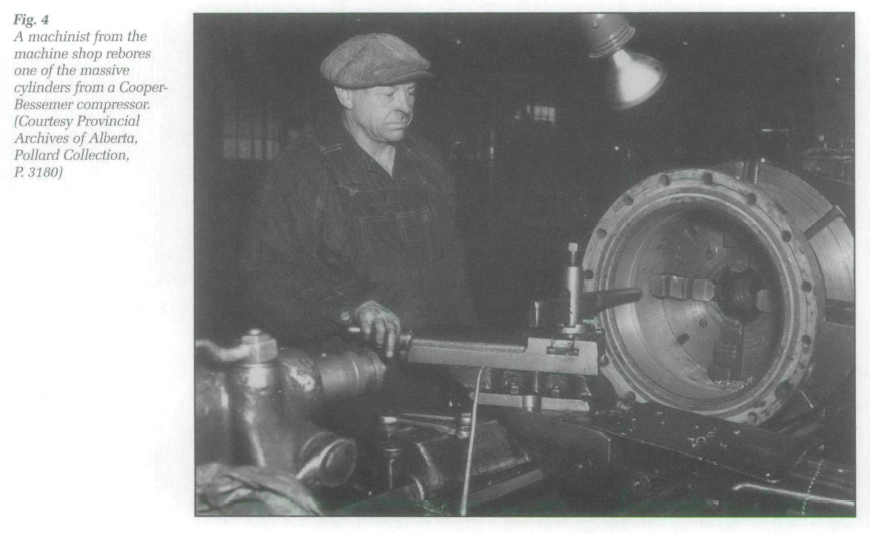 Display large image of Figure 4
Display large image of Figure 4Resource Materials for a Case Study: The Turner Valley Gas Plant
28 For the non-specialist about to embark on research relating to the technology employed to process natural gas at Royalite Plant #1 in Turner Valley from the 1920s until the 1980s, Fred Stenson's little book Waste to Wealth — A History of Gas Processing in Canada (1985) is the best starting point. This monograph, written for the Canadian Gas Producers Association, is very well researched, the prose is a pleasure, the organization is tight and arranged both topically and chronologically. It is well illustrated and he takes special pains to ensure that the processing methods are clearly laid out for the reader.
29 Stenson has taken pains to acknowledge the place of Turner Valley's Plant #1 (Plant #2 having been moved from the south end of the field and consolidated with #1 in 1944) in the history of gas processing in Canada, so that the researcher is very quickly able to place it in the technological continuum.
30 His bibliography, while brief, points one toward valuable secondary source material in the form of monographs, the Petroleum Industry Oral History Project (see below), the Glenbow Archives collections (see below), Oilweek, Canadian Oil and Gas Industries, and the annual report published by the Department of Energy, Mines and Resources in Ottawa: Natural Gas Processing Plants in Canada.
31 He also directs the researcher to the valuable technical papers found in the Canadian Gas Producers' Association Lending Library in Calgary. These papers cover topics of industry-wide significance and the Turner Valley plant is referred to in some of the earlier ones. A reading of the Stenson book will give the researcher a good working knowledge of the industry and provide an introduction to Royalite Plant #1 and the history of its operation until its closure.
32 To supplement Stenson, while still remaining within the time period of the plant's operational life, the researcher is also referred to Kelly Gibson's chapter "Natural Gas Processing" in James Hilborn's Dusters and Gushers: The Canadian Oil and Gas Industry (1968), a piece written for the lay audience. Problems encountered in the processing of natural gas are outlined by Dr. George W. Govier, latterly Head of the Department of Chemical and Petroleum Engineering, University of Alberta, Edmonton, and member of the Conservation Board, in "Engineering Problems Related to Alberta Natural Gas," which appeared in The Engineering Journal (August 1952).
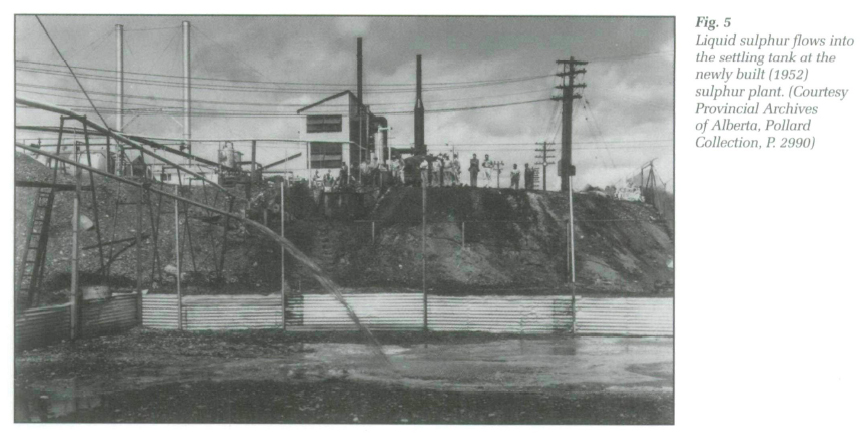 Display large image of Figure 5
Display large image of Figure 533 As an exercise in comparing and contrasting, J. Dick and G. W. Stephens, authors of "Gas Technology: Energy Conservation in Natural Gas Plants — Then and Now," have published an interesting piece in The Journal of Canadian Petroleum and Technology (October/December 1978). This detailed article has a tendency to highlight gas fields and plants that emerged after Turner Valley, but when used together with other materials referred to below one can discover certain technical problems that were also dealt with at the Royalite plant.
34 Scattered throughout a number of other secondary sources the researcher will find bits and pieces of information relating to the technical operation of the plant. A select set of sources would consist of, for example, In the Light of the Flares (1979), a local history of the Turner Valley area compiled by the Sheep River Historical Society. This volume contains references to the plant's history, both in sections of explanatory text as well as in an anecdotal format. The informants are editorial committee members as well as former plant operators, tradespeople, labourers, laboratory employees, engineers, and supervisory personnel. David A. Finch's Master of Arts thesis Turner Valley Oilfield Development, 1914-1945 (1985) also has as one of its many and diverse themes the gas plant and its early development. But these two pieces do not delve deeply into the technical side of gas processing; to gain the technological perspective one must search elsewhere.
35 One aid that the researcher will find helpful was compiled by interpretive guides from Historic Sites Services, Alberta Community Development, who worked at the gas plant. It consists of three straightforward sets of question and answer sheets that supplement and elaborate on the amount of information on gas processing revealed in the Stenson book. The first bears the title "General Industry/ Science" and it explains the technical terminology and the functioning of the natural gas industry at large. A second set is entitled "Turner Valley Industry Questions" and it includes historical material as well as the terminology and background to drilling for oil and gas. Finally, connected to these is a set of "Gas Plant Questions," which focus on the processing methods, some of the types of equipment used and their roles, the dates structures were erected and various upgrades made, and safety matters. This simple question-answer format is a quick and effective introduction to some of the general features of the industry and the Turner Valley field, as well as some of the particulars of the gas plant itself.
36 These sets make good advance reading for two other basic pieces on the plant that are in the possession of the Historic Sites office in Edmonton. The earliest (1960?) of these is a typescript attributed to Ed Nichol, a former plant operator, and it bears the title "Turner Valley Oil and Gas Field." Nichol has a keen interest in the plant's history and is a willing source of information for any researcher interested in his former place of work. The typescript discusses the development of the field, drilling practices, completion practices, the gas industry (and thus the plant), and the shipment of crude oil to the market. Attached is a Western Decalta (1977) fact sheet dated 81.10.26, and a site map of the plant. The second is the type-script of an interview with David Finch conducted 15 June 1995, which is far-reaching in its scope. The plant and its technology feature in several parts of the interview.
37 In order for a researcher to proceed with a study of the plant's equipment and technology, and then to document the findings clearly, a set of relevant images of the site as it changed over time is valuable. Fortunately such images exist in the form of the Harry Pollard Collection, currently held by the Provincial Archives of Alberta. Pollard, who was in Turner Valley in 1914 when the Dingman discovery well blew in, recorded the history of the area and left us with a rich visual legacy. He retired in 1954, and in 1964 he donated to the Province of Alberta his entire collection of over 10 000 negatives. His photographs, which include both Royalite #1 and #2, go back to the early 1920s.
38 He had, at various times until his retirement, captured on film the original absorption plant and each of the processing units that were added on the site up to the construction of the sulphur extraction plant in the early 1950s. The photographs range in format from those taken at a distance from the surrounding hills to those shot over the shoulder of an operator as he watches a control gauge and closes a valve. Various procedures are captured on film — ranging from oil testing (1945) to operating compressors (n.d.) — and there are many closeup and distance shots of machinery and laboratory procedures. Sprinkled here and there one also finds photographs of important field plans (such as a flow diagram of the gas scrubbing plant using the Koppers-Seaboard Process) and documents like the copy of a construction permit granted to Royalite in 1943 by the Department of Munitions and Supply for the purpose of constructing new buildings in order to meet the needs of the war effort.
39 From the point of view of capturing the external appearance of the evolving technology of gas processing as well as construction phases and the features of structures, these photographs are invaluable. However, they are also of assistance when one wishes to trace the evolution of such simple techniques as how the sulphur was "mined," moved, and loaded into rail cars, firewalls were built and maintained around tanks, joints welded, and how riveted pressure vessels were employed at certain locations within the plant.
40 To be used in conjunction with these images the researchers will find a useful document compiled for Alberta Culture by David Finch and Brian Reeves. Entitled Historical Resources Impact Assessment — Turner Valley Gas Plant (1986), this study is an introduction to the plant's history. It contains an historical synthesis of each operating unit with an elementary description of the processes involved there. This synthesis begins with the compressor house and follows on through to the final stage of processing, and thus it takes the researcher through the entire plant. Every structure at the plant is located on a large foldout site map tucked away in the back of the book, and the description of the units and their operation is accompanied by a series of photos of each building as it stood in 1986.
41 In addition, in appendix form there are copies of blue print drawings of each unit's building (propane, gasoline, etc.) and of detailed flow diagrams outlining the chemical process taking place inside of it. This comprehensive document's easy-to-read text also emphasizes the plant's significance to the history of natural gas processing in Canada and, like the Stenson book, helps to situate it in the continuum of natural gas processing history.
42 At another level, the researcher has access to a useful guide to what is to be found within the plant compound. A detailed inventory of all the equipment on the site was completed for Historic Sites Services, Alberta Community Development, by the Curator of Transportation and Industry at the Reynolds Alberta Museum, Wetaskawin, Alberta. This inventory contains a system of building codes, a current sitemap, and a key to indicate what piece of equipment on the map is a boiler, a furnace, a tank, a motor (pump, fan), and so forth. Each piece of equipment is designated its own inventory page, which gives its serial number, manufacturer's name, and its operating specifications. A "Notes" section on the page includes any additional information of importance such as whether the equipment has been dismantled, if there is a cross-listing for it, if it is located in a building within a building, if a part such as an electric motor is missing, or if there is a peculiarity about a portion of the assembly, such as a particular boiler type or method of mounting.
43 If in its most simplified form history is an analysis of change over time, then the primary source materials available to trace the evolving technology and hence this change at the Turner Valley plant are not always as numerous as one might wish. In addition, with the exception of the Stenson book, not a great deal has been written on the industrial technology associated with this particular plant. For example, in his book Alberta's Petroleum Industry and the Conservation Board (1993), David Breen does an admirable job of dealing with the wide-open manner in which the Turner Valley field once operated, and of showing how such a situation helped to speed the creation of this regulatory body. But his focus, like that of most historians who have written on the oil and gas industry, is not on the evolving technology. Furthermore, when petroleum technology is in the limelight, it is usually the technology of exploration and, then secondly, of production. Gas processing places a somewhat distant third, hence the value of Waste to Wealth. From what sources, then, does the researcher dig out the material on the technology employed at Royalite Plant #1, and on how the plant functioned over time?
44 In relation to its operation, it could be said of the plant that "Much was done, but it wasn't always recorded." Manuscript and other allied sources do exist on the Turner Valley oil and gas field, but upon closer examination the value of some of them to a study of gas technology is often peripheral. The Provincial Archives has a number of manuscript holdings dealing with Turner Valley, but few actually relate directly to the operation of the gas plant. The Glenbow Alberta Institute, on the other hand, has several important collections which, when mined with care, yield information of value. The Royalite Oil Company holdings are, in general, not of a technical nature, and when technology becomes an issue it tends to be in relation to profits, the law, or marketing the firm's products.
45 However, the Annual Reports, especially those still surviving for the period 1950 onward, contain factual informadon about how the plant was operating, its problems, and what attempts were being made to solve them. There is also a very useful collection of Royaliter magazines and the Royalite Oil Report, which contain important articles (see below) written by employees on the functioning of the plant's units. There is also a file for a 1936 Clark compressor (M1527), one of the plant's workhorse pieces of equipment, as well as the Home Oil collection, which holds a number of copies of the Royalite Annual Report, which contain commentaries on plant operation. The Glenbow also houses the fruits of the Petroleum Industry Oral History Project, a collection of tapes and transcripts of interviews gathered by a team of recorders in the early 1980s (see below).
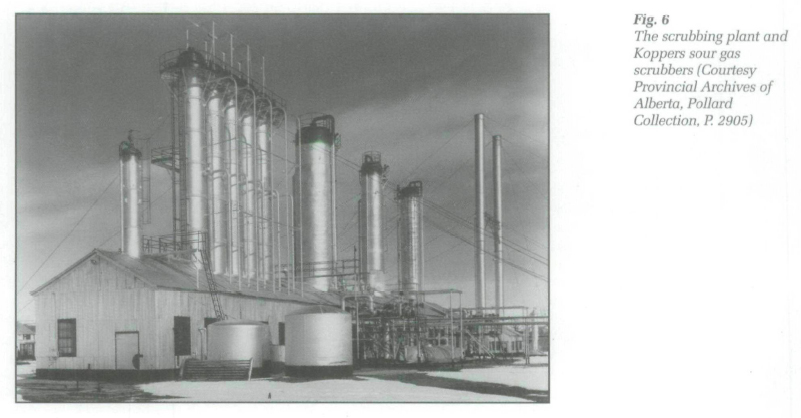 Display large image of Figure 6
Display large image of Figure 6 Display large image of Figure 7
Display large image of Figure 746 A number of articles exist that would be of considerable help in explaining the various processes used at the plant and in linking them to the above mentioned equipment. One of the earliest was by Samuel G. Coultis, Royalite's first (1920) field employee. In charge of natural gas and naphtha production, Coultis designed and rebuilt the first absorption plant after it was destroyed by fire in October, 1921. The 1921 absorption plant was a change in technology in that absorption oil was sprayed on the raw gas in both horizontal and vertical absorbers. (The first plant has only horizontal absorbers.) In "Production Methods in the Turner Valley Field," published in The Imperial Oil Review (December 1928), Coultis explained production methods at the plant at that time. He leaves us with detailed chemical descriptions of the mechanical processes. The hazards of operating a gas plant in the early days are brought home to the public in another Imperial Oil Review article (January/February 1932) entitled "Explosion at Royalite Scrubbing Plant," which outlined the nature of an explosion and fire at one of the busiest and most dangerous parts of the processing.
47 Other employees of the Company also published articles on the plant's operation. The decision by Royalite in 1951 to convert hydrogen sulphide then being exhausted to the atmosphere into sulphur was made public in some depth by Gordon A. Connell, Chief Petroleum Engineer for the Company, and Robert V. Jones, Design Engineer for Foster Wheeler Limited, the equipment supplier, in The Royalite Oil Reporter (November 1951). "Raw Sulphur From Hydrogen Sulphide" should be read in conjuction with Donald D. Dunbar's piece "Construction and Operation of Royalite's Sulphur Recovery Plant," which appeared in The Engineering Journal (April 1953). Dunbar, the Company's Assistant Civil Engineer at Turner Valley, played a key role in the design and early operation of the sulphur plant. His article, delivered at the Calgary Branch of the Engineering Institute of Canada in October 1953, gives considerable background on the plant prior to the new addition, the start-up, physical aspects of the site, the bauxite catalyst used in the process, and a host of other topics related to its operation. At a less sophisticated level there is an anonymous insert in The Royaliter (May/June 1956) detailing the sulphur plant's operation, for the benefit of those employees involved in exploration, production, or the office.
48 Alex G. Piercey, the Company's Chief Chemical Engineer in Turner Valley in the early 1950s, also wrote on the operation of the gas plant. As an employee of the Madison Natural Gas Company, a Royalite subsidiary responsible for processing the raw gas from the field, Piercey took an active interest in explaining the Madison Laboratory and the plant's operation to the petroleum industry, the engineering progression, and the Royalite community.
49 "The Madison Laboratory — New Techniques" was published in The Royalite Oil Reporter (June 1950). It was a historical overview of the laboratory as well as an elementary account of the services it performed for the plant and the field. "Gas and Gasoline Plant Operations in Turner Valley," which appeared in Canadian Oil and Gas Industries (November 1951), was true to its tide and did, in fact, explain the operation of the plant as a whole and the gasoline plant as a sub-unit. Piercey also took an interest in the financially troubled propane plant purchased by Royalite from Jim Barber of Western Propane, half a mile up the Sheep River from the Royalite/Madison plant at Cuffly Flats, and moved to the main site. In December, 1952 his article, "The Royalite Propane Unit," appeared in The Royalite Oil Reporter. A study in clarity, it was written, once again, for employees at all levels and it is a pleasure to read.
50 For the engineers, Piercey crafted "The Propane Unit of the Royalite Oil Company," which contained the same basic material as the above but which was pitched at the profession, and came out in The Engineering Journal (April 1953). Corrosion, and the embrittlement of metal, problems created by hydrogen sulphide and carbonic acid, prompted Raymond S. Phillips to draft an insert for The Royalite Oil Reporter (June 1959) entitled "Corrosion Problems in Gas Scrubbing Plants." In the article he displayed a sound knowledge of the problem and emphasized that high concentrations of corrosive gases in the gas stream would promote different forms of corrosion throughout the entire plant.
51 The gasoline plant's earliest exposure, on the other hand, went to press without the benefit of either an author or a very high level of sophistication. Published in The Imperial Oil Review (June 1922) as "Making Gasoline from Gas," it is only an overview of the natural gas producing situation in the Bow Island and Turner Valley fields, but it does contain an informative section on the compressing station, the absorption plant, and the production of gasoline.
52 On a much more sophisticated plane, and almost thirty years later, Alex McRae, Royalite's Superintendent of Production in Turner Valley, inserted "Royalite Operates Modern Gasoline Plant in Turner Valley Field" in the December 1950 issue of The Royalite Oil Reporter. The point of McRae's article was to demonstrate that ingenuity and accumulated "know-how" were the basis for an ongoing supply of absorption gasoline arriving at the Calgary refineries. Built in 1932, the absorption plant was the first of its kind in Alberta, he noted, and with the later addition of a fourth absorber tower in 1933 it was capable of extracting gasoline from over one hundred million cubic feet of wet gas per day. The piece gives the Company audience a straightforward explanation of how gasoline was extracted from "wet" natural gas.
53 Thus we have available for the researcher some useful secondary printed material, photographs, a resources impact assessment containing explanatory material on the plant's chemical processes, the site's buildings, and the equipment, a complete equipment inventory, the record of the Royalite Oil Company deposited with the Glenbow, some miscellaneous related files, reports, and ephemera, and a selection of articles written by people who were intimately familiar with the plant's operation.
54 A necessary next step involves making a more detailed examination of the technology used to support the various processes used at the Turner Valley plant. Here we turn to one of the richest sources available to the researcher, the Royalite Oil Company records stored at the Historic Sites storage facility in Edmonton and at the Historic Sites office at St Stephen's College, University of Alberta. These holdings relate, though not always in the most obvious of ways, to the day-to-day operation of the plant and, in some cases, to the Turner Valley field at large. Unlike the Royalite records at the Glenbow, which tend to involve the mind of the company in the form of minute books, lease agreements, and the like, these in Edmonton represent one of the organization's vital organs.
55 Here one finds manuals and equipment catalogues, plant operator's daily journals, daily equipment data reports, operational records for the plant's different units, plant inspection certificates stretching back to the 1930s, and so forth. This collection of documents depicts what operating a natural gas processing plant involved. There is a portion of this collection at St Stephen's College and it is critical to any study of the plant's technology. Here the researcher will find a plant-wide set of blueprints and drawings dating from the 1960s onward. On these one can trace some (for not all changes were recorded) of the dated changes made to the plant's various pieces of equipment over the years. There are also floor plans for buildings, sewer and water line locations, electrical wiring created for the various plant owners — Royalite, British American, Madison, Western Decalta — while others were provided by the suppliers of the equipment — Cooper-Bessemer, Clark, Fluor Corporation, C. F. Braun, Jackson Engineering, Canadian General Electric, Anglo-American, and so on.
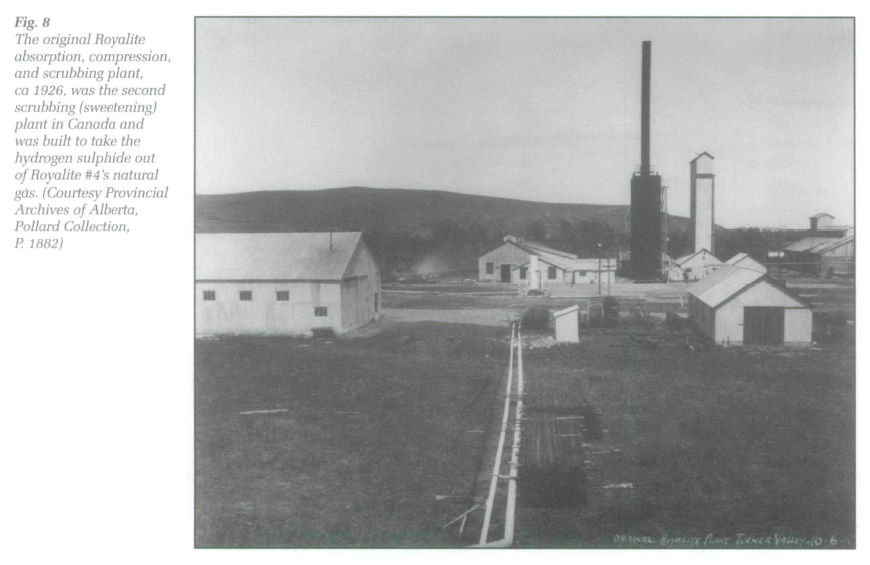 Display large image of Figure 8
Display large image of Figure 856 Of special note is a file box containing background information on the sulphur plant and the role played by Donald Dunbar (see above) in its design, construction, and start-up. These historical drawings have finder guides to accompany them but several boxes of files, while listed, do not have a precise breakdown of all of the contents. This in no way hinders the researcher. The older (onion skin) copies of letters and memos must be handled with care.
57 At the time of writing (1996) a collection of twenty-three boxes of Royalite and successor company records is in the possession of the Turner Valley Historical Society, but kept at STACS, a record storage firm in Calgary that had held them previously for Pembina Oil and Gas, the parent company of Western Decalta. This is a varied collection; it involves production matters as well as the gas plant operation. Mixed in with well maintenance and production information and statistics the researcher will come across construction drawings, time and payroll sheets, equipment catalogues, corrosion studies, information on gas plant operations, salt water reports, auditors' reports, memos of various kinds, financial statements, contracts and agreements, and so on. Unfortunately, the file index is not entirely accurate, nor do all of the files carry the appropriate labels. There is some plant related material in this collection, but finding it is a challenge given the manner in which the files have been named, and the lack of adequate identification for some of the others. It should be noted that a small number of the older documents are fragile. A small, but useful group of materials is located at the Historic Sites Services' southern Alberta office in Calgary. It consists of gas compressor diagrams for the W.D. Superior Compressor, a flow diagram for the Koppers-Seaboard Process, and a 1939 technical chart relating to the use of charcoal in natural gas processing.
58 All of these primary documents have potential value but will, in all likelihood, come alive mainly through the human element. The articles written by plant employees are important, but the authors are now almost all deceased and thus they cannot be sought out for additional information or clarification. We do have on record the stories of a number of leading figures in the history of the Alberta petroleum industry, among them people who have spent time at the Royalite plant in Turner Valley. While the focus of the interviews was not on that gas plant, from time to time nuggets were exposed that do, in fact, add to our store of information.
59 The first of these tape recorded sessions to capture the living memories of Alberta's oil and gas pioneers commenced in 1981 and ended in 1985. Staff of the Petroleum Industry Oral History Project conducted 221 interviews. The results, in tape form and in summary sheet form for each interviewee, are lodged with the Glenbow Museum in Calgary. Respondents were involved in all aspects of the petroleum industry — exploration, production, refining, and support for employees of the oil and gas companies— in all of Alberta's producing fields as well as overseas. Each was asked to respond to a set of generic questions relating to their occupation, their employers, etc. Some of the respondents were involved with gas production in the Turner Valley field and processing at the Turner Valley Royalite plant, notably Ian Drum, Mark Blain, and Ralph Osborne. (A copy of their summary sheets is held by Historic Sites at St Stephen's College).
60 Their reminiscences add to the information collected by David Finch in the course of fifty-one interviews with Turner Valley area residents and oil industry ex-employees in 1991. Historic Sites has no tapes for interviews 1 to 10, but it does hold the transcripts. Duplicate copies of transcripts are available for interviews 11 to 20, and tapes and transcripts for interviews 11 to 30. The author has transcripts for interviews 1 to 51, courtesy of David Finch.
61 Those whose personal histories contain information with direct bearing on the operation of the plant are Eric Mulder, Thomas Trotter, James Donnelly, Maurice Edwards, Lawrence Barker, Ruth Pearson, Geoff Andrews, Alex McKellar, and Ralph Steen. From their stories the researcher will be exposed to information not available from company records. One interesting statement was made by Ruth Pearson (spouse of "Bud" Pearson, a plant manager responsible for maintenance), who worked in the plant office, keeping records for all parts of the operation, and retired in 1980. She commented that most of the records from the plant, which she had indexed, were burnt during the 1970s. (Interview 017, 21 March 1991, Tape 1, Side 2, 065-085).
62 A third set of interviews relating directly to the plant and its operation was conducted by David Hill in 1992 for the Turner Valley Waste Management Study. Because it focuses so directly on what took place on the site it appears to be the most valuable of the oral history projects relating to the plant. A copy of this series is on file with Historic Sites at St Stephen's College. It consists of extensive summaries for each of the thirty-six ex-employees who were interviewed. The thrust of the study was the impact of hazardous chemicals on the site and the surrounding area, but this did not prevent the respondents from explaining in detail the operation of the plant and its ancillary services. Some of their comments reveal information about the plant's processes, equipment, and operating procedures that will probably not be foimd elsewhere.
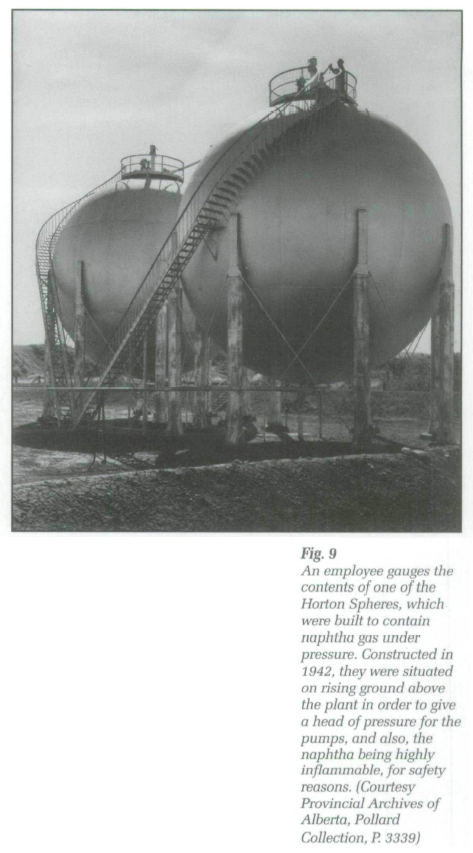 Display large image of Figure 9
Display large image of Figure 963 These various oral summaries allow a clearer view of how the processes and equipment functioned. When combined with the sources mentioned earlier in the article they provide a good base from which to study the plant's evolving technology. However, in terms of the human resource, the research does not end here. There is still a need to interview the remaining former plant employees in order to clarify points raised by the documents and in the course of the previous interviews, and to obtain answers to questions that will arise in the course of future research.
Conclusion
64 On 13 February 1997 Alberta celebrated the fiftieth anniversary of the blowing in of Leduc #1, the oil well that is usually seen as heralding the coming of the petroleum boom to this province. Much was said by the media of this event and the impact it had upon the people of the province and the provincial economy. The Alberta oil and gas industry is seen as having its genesis at Leduc. But the industry really had its beginnings southwest of Calgary, in Turner Valley, and it was here that it had its "nursery."
65 From Turner Valley came future generations of rough necks, engineers, drillers, plant operators, tool pushes, pipe liners, service rig hands, and battery operators, and they spread out into the Leduc-Woodbend and Redwater fields, and then coundess others like Drayton Valley, Violet Grove, and Judy Creek. These individuals provided the expertise required to drill for, produce, and process oil and gas discoveries.
66 Equipment and techniques for processing sour gas were developed or perfected in Turner Valley, passed around the province, and sent elsewhere. The plant was an important starting point in the history of gas processing in Canada, and it has earned its designation as an historic site. For the researcher who wishes to undertake a case study of the technology of natural gas processing at Canada's oldest plant, the resources have been preserved, they are accessible, and they are both varied and informative.